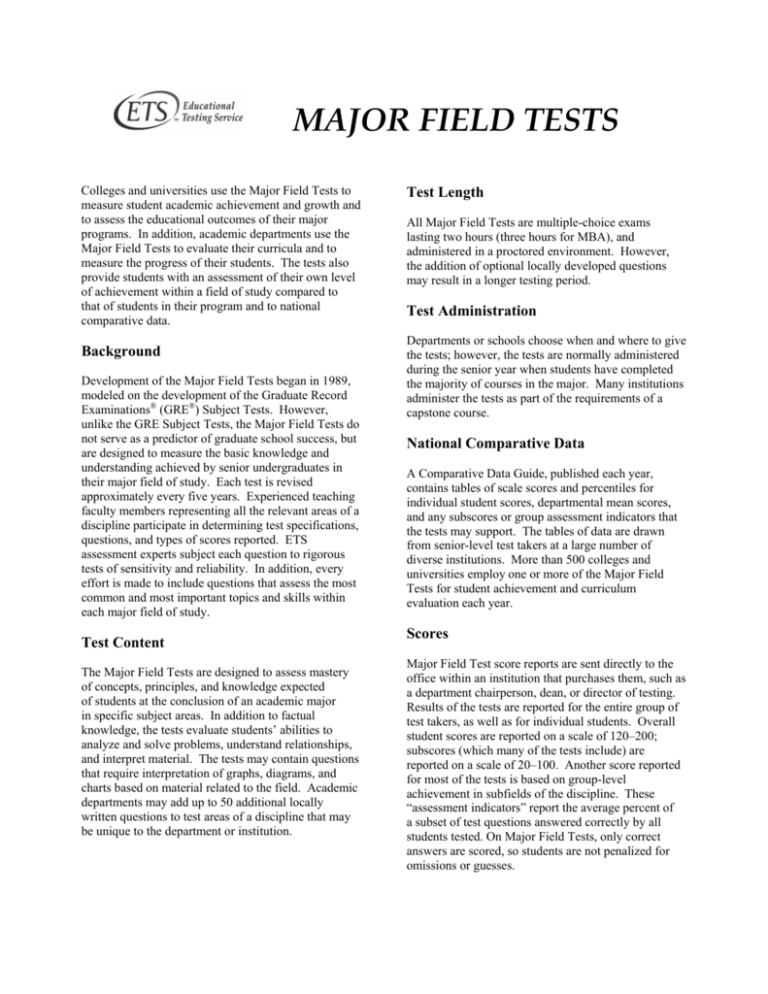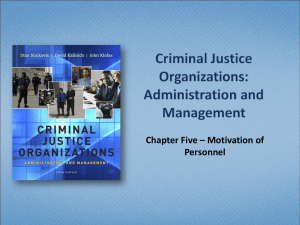
MAJOR FIELD TESTS
Colleges and universities use the Major Field Tests to
measure student academic achievement and growth and
to assess the educational outcomes of their major
programs. In addition, academic departments use the
Major Field Tests to evaluate their curricula and to
measure the progress of their students. The tests also
provide students with an assessment of their own level
of achievement within a field of study compared to
that of students in their program and to national
comparative data.
Background
Development of the Major Field Tests began in 1989,
modeled on the development of the Graduate Record
Examinations® (GRE®) Subject Tests. However,
unlike the GRE Subject Tests, the Major Field Tests do
not serve as a predictor of graduate school success, but
are designed to measure the basic knowledge and
understanding achieved by senior undergraduates in
their major field of study. Each test is revised
approximately every five years. Experienced teaching
faculty members representing all the relevant areas of a
discipline participate in determining test specifications,
questions, and types of scores reported. ETS
assessment experts subject each question to rigorous
tests of sensitivity and reliability. In addition, every
effort is made to include questions that assess the most
common and most important topics and skills within
each major field of study.
Test Content
The Major Field Tests are designed to assess mastery
of concepts, principles, and knowledge expected
of students at the conclusion of an academic major
in specific subject areas. In addition to factual
knowledge, the tests evaluate students’ abilities to
analyze and solve problems, understand relationships,
and interpret material. The tests may contain questions
that require interpretation of graphs, diagrams, and
charts based on material related to the field. Academic
departments may add up to 50 additional locally
written questions to test areas of a discipline that may
be unique to the department or institution.
Test Length
All Major Field Tests are multiple-choice exams
lasting two hours (three hours for MBA), and
administered in a proctored environment. However,
the addition of optional locally developed questions
may result in a longer testing period.
Test Administration
Departments or schools choose when and where to give
the tests; however, the tests are normally administered
during the senior year when students have completed
the majority of courses in the major. Many institutions
administer the tests as part of the requirements of a
capstone course.
National Comparative Data
A Comparative Data Guide, published each year,
contains tables of scale scores and percentiles for
individual student scores, departmental mean scores,
and any subscores or group assessment indicators that
the tests may support. The tables of data are drawn
from senior-level test takers at a large number of
diverse institutions. More than 500 colleges and
universities employ one or more of the Major Field
Tests for student achievement and curriculum
evaluation each year.
Scores
Major Field Test score reports are sent directly to the
office within an institution that purchases them, such as
a department chairperson, dean, or director of testing.
Results of the tests are reported for the entire group of
test takers, as well as for individual students. Overall
student scores are reported on a scale of 120–200;
subscores (which many of the tests include) are
reported on a scale of 20–100. Another score reported
for most of the tests is based on group-level
achievement in subfields of the discipline. These
“assessment indicators” report the average percent of
a subset of test questions answered correctly by all
students tested. On Major Field Tests, only correct
answers are scored, so students are not penalized for
omissions or guesses.
CRIMINAL JUSTICE (4BMF)
(Current form introduced in 2005)
The Major Field Test in Criminal Justice consists of
150 multiple-choice questions, some of which are
grouped in sets and based on such materials as
diagrams, graphs, and statistical data. Most of the
questions require knowledge of specific information
about the criminal justice system, but the test also
draws on the student’s critical thinking ability; that is,
the ability to interpret data, to apply concepts and
ideas, and to analyze data, theories, and relationships,
deductively and inductively.
III.
Corrections (about 20 percent of the
questions)
A.
B.
C.
D.
E.
F.
G.
The broad field of criminal justice encompasses many
subfields and specialities; this test covers the skills and
subject matter included in most undergraduate
programs. The distribution of the content areas with
some examples of the topics covered is as follows:
IV.
The Court System in the United States (about
20 percent of the questions)
A.
I.
A.
B.
C.
D.
E.
F.
G.
H.
II.
B.
C.
D.
E.
F.
G.
The Law (about 20 percent of the questions)
Civil vs. criminal law
Defining a crime (elements of a crime)
Defenses
Constitutional law
Major alterations to the law
The sociology of law
The philosophy of law
Criminal liability
V.
History and philosophy of corrections
Juvenile vs. adult systems
Probation and parole
Theories of punishment
Prison organization and management
Issues and trends (including
privatization)
Community corrections
History of the court system in the
United States
Pre-trial issues
Plea bargaining
Courtroom culture (the actors)
Sentencing
Organization and management
Judicial decision-making
Theories of Criminal Behavior (about 20
percent of the questions)
A.
B.
C.
D.
Classical theories
Positivist theories
Conflict theories
Integrated theories
Law Enforcement (about 20 percent of the
questions)
VI.
A.
B.
C.
D.
E.
F.
G.
H.
Social function of the police
Role of the community in defining the
police role
History of the police in the United
States
Critical issues including corruption
Investigative techniques
Police subculture (informal)
Police organization and management
(formal)
International issues and terrorism
Critical Thinking
Critical thinking and research methods and statistics
questions are integrated into the entire test. About 25
percent of the questions address one of the topics above
in a way that requires critical thinking skills. About 10
percent of the questions above address one of the topics
in a way that focuses on research methodology and
statistics.
Critical thinking questions require students to:
•
•
•
Draw inferences from theories and data
Recognize unstated assumptions
Deduce conclusions from information
presented in statements or premises
•
•
•
•
•
•
VII.
Interpret and weigh evidence as to
whether asserted conclusions are
warranted
Evaluate the strengths of comparable
arguments regarding a specific issue
Apply knowledge to new problems
Read and interpret tables of data and
graphs
Recognize the strengths and limitations of
both quantitative and qualitative data
Compare and contrast subjects and ideas
Research Methodology and Statistics
Research methodology and statistics questions require
students to understand:
•
•
•
•
•
•
Quantitative and qualitative methods
Research design (including basic and
applied approaches and ethics in research)
Statistics with application to criminal
justice subject matter
Sampling
Statistical software
Hypothesis testing
Scores on the Major Field Test in Criminal Justice are
reported as follows:
Total Score:
Reported for each student and summarized for the
group.
Assessment Indicators (Mean Percent Correct):
Reported for the group* only.
• Theory (30)
• The Law (30)
• Law Enforcement (30)
• Corrections (30)
• The Court System (30)
• Critical Thinking (37)
• Research Methodology and Statistics (15)
__________________________
Numbers in parentheses are approximate number of questions in each
category.
*A minimum of five students is required for assessment indicators to
be reported.
Copyright © 2005 by Educational Testing Service. All rights reserved. EDUCATIONAL TESTING
SERVICE, ETS, the ETS logo, GRADUATE RECORD EXAMINATIONS, and GRE are registered
trademarks of Educational Testing Service. HIGHER EDUCATION ASSESSMENT is a trademark of
Educational Testing Service.
Permission to reproduce this document is hereby granted to institutions (colleges and universities)
administering the Major Field Tests for internal use only. No commercial or further distribution is
permitted. Other persons or agencies wishing to obtain permission to reproduce this material may write to
the Permissions Administrator at Educational Testing Service, Princeton, New Jersey 08541.





